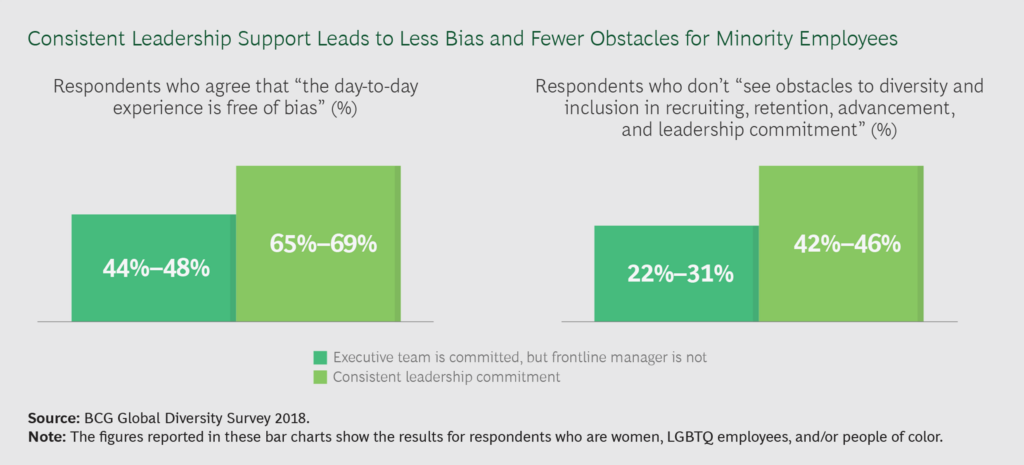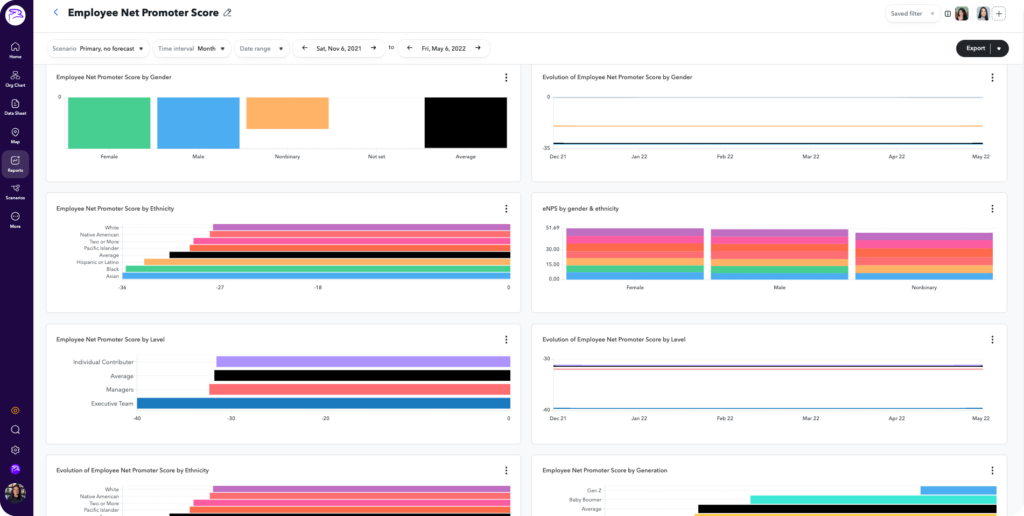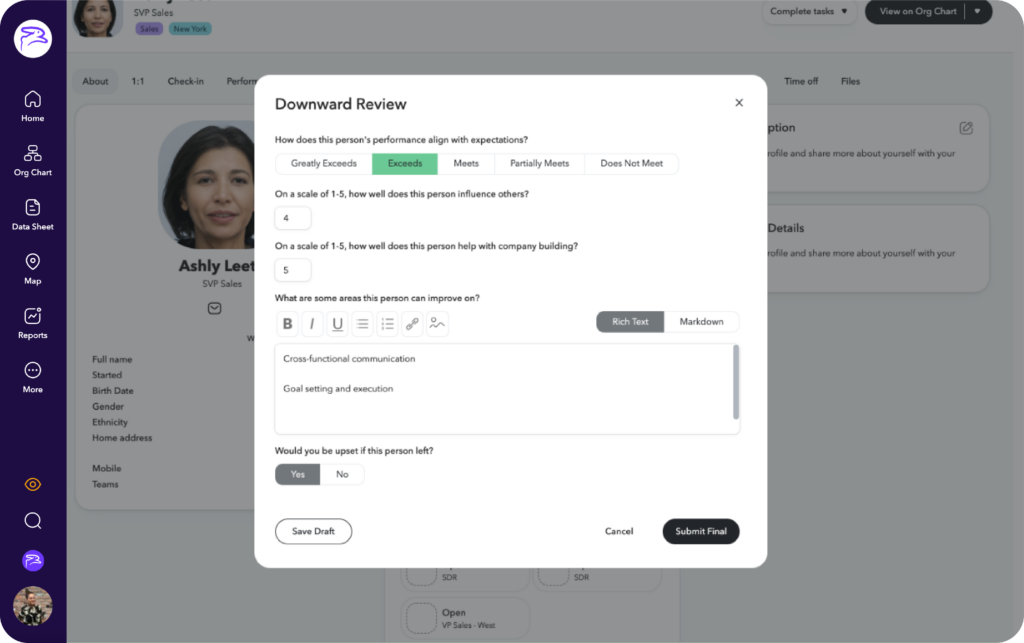
Tell us if this sounds familiar: Senior leadership develops an exciting new DEIB strategy and announces their vision to all employees. Everyone attends a company-wide training on creating a more inclusive environment. But then days, weeks, and months pass, and all efforts seem to come to a standstill.
What happened? The glaring error is that inclusion tactics weren’t woven into the fabric of the company’s culture. It turns out that for DEIB efforts to make an impact, leaders need to embed it into all business and people decisions.
This includes training middle management, who are involved in hiring, promoting, and managing employees. Managers are your DEIB linchpin, and their buy-in and support are essential to ensuring your efforts are successful across teams and departments.
When Boston Consulting Group (BCG) surveyed 16,500 employees around the world, 97% reported that their companies had diversity programs in place. Despite that, nearly half of the respondents confessed that bias was still present in their day-to-day experience at work.
The missing factor? Consistent support for diversity and inclusion from their managers.
When managers buy into diversity and inclusion initiatives, they transform an intention into meaningful action, all while making a positive impact on the employee experience.
Dr. Melissa Thomas-Hunt, Head of Global Diversity and Belonging at Airbnb, highlights the power managers have on their direct reports. She says: “[Managers are] the ones with the power to make employees feel safe enough to contribute their knowledge and perspectives. A great supervisor is someone who creates an environment in which a diverse array of people can succeed.”
In short, we know that good managers interact with their direct reports on a daily basis: they run team meetings, conduct 1:1s, and help their people reach their goals. With each interaction, managers can champion your company’s initiatives and culture, especially when it comes to diversity and inclusion. But to achieve manager buy-in, you must first equip managers with the skills and training necessary to support employees from all backgrounds and with different levels of experience.

When managers consistently support diversity and inclusion initiatives, their people that identify as underrepresented talent are more likely to report a bias-free work experience.
Ready to empower your managers to help drive your DEIB efforts? Check out the following four tactics to increase the success of your diversity and inclusion strategy.
Although companies spend $8 billion a year on external DEIB consultants, programs, and workshops, many fall short when it comes to putting that knowledge to practice (which unfortunately means that efforts almost always fail).
So while it might seem like a good idea to bring in external consultants as a set of fresh eyes, consider the benefits of turning to people who know your company best: your managers.
Capitalizing on your managers’ collective experience – and pairing these internal resources with the expertise and insight of external consultants – allows for better execution and training-to-real-life application.
Why? Managers know your workforce, your workflows, and the processes that you can use to introduce diversity and inclusion efforts. They can also identify real-life challenges – not hypothetical situations – and troubleshoot solutions.
When you involve middle managers in creating a diversity and inclusion strategy, you give them (and your company) the opportunity to own your efforts rather than transferring that responsibility to a third party. That means you’ll plan according to what is best for your people and make decisions based on your data.
When you tap your top-performing managers to help drive your DEIB efforts, consider doing the following:

Look at all of your people data to determine which managers are top performers. Luckily, with a people operations platform, you can filter data by team and department to pinpoint strong managers.
Clear communication is important for any initiative, but especially for your DEIB strategy. Unfortunately, research suggests that managers don’t always understand the role they play in diversity and inclusion initiatives, and that this lack of understanding directly impacts their level of commitment.
It’s therefore critical to share your vision, expectations, and follow-up procedures so middle management understands their responsibilities. Additionally, by providing information in multiple settings and formats (such as All Hands meetings, 1:1s, and manager trainings), you ensure the right people hear the same information so there’s no confusion down the road.
When you clearly communicate expectations to your middle managers, you help drive home the importance of their role and commitment to your DEIB efforts. When setting expectations, make sure you:
Diversity and inclusion should never be treated as a list item to check off. Instead, DEIB is a long-term commitment to investing in and advancing employees from all backgrounds.
That’s why it’s a good idea to include DEIB efforts in middle managers’ performance reviews. When managers know their efforts factor into their individual review and advancement opportunities, they are likely to prioritize these initiatives to help better their team and company as a whole.

Upward and downward reviews allow employees and executives to provide feedback on managers. Asking for specific feedback can help create a stronger team dynamic, pinpoint areas of concern, and identify possible next steps in your DEIB strategy.
Even though managers interact with and manage close to 80% of an organization, they receive only 20-30% of an organization’s training budget and efforts. This figure becomes more troublesome when you consider how many of these managers are first-time managers and are unprepared for the role, especially at fast-growing companies.
Companies should therefore provide ongoing training and support that equips middle management with the tools and skills needed to strengthen their DEIB efforts.
How do you deliver crucial training in a way that is impactful and long-lasting? Consider the following:
Smart leaders partner with middle management to help ensure a successful diversity and inclusion strategy. But instead of just requiring your managers to implement initiatives, make sure you include them in building the strategy, communicate expectations, hold them accountable, and provide ongoing training.
By equipping managers with the necessary skills and tool sets, you’ll empower them to become an active ally – one that’s invested in the growth, success, and day-to-day work experience of their teams.
Sign up for a free demo today.